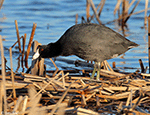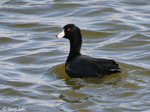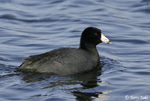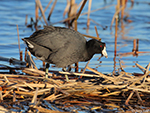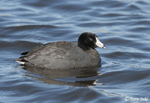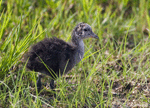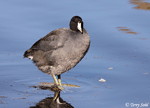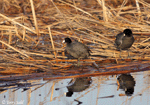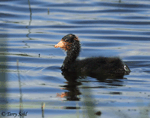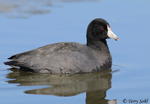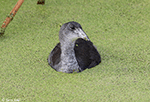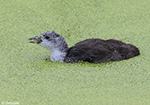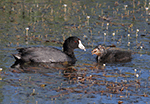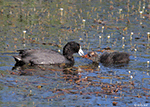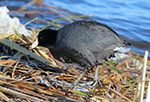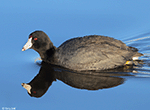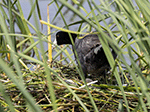| Length: 15 inches | Wingspan: 25 inches | Seasonality: Summer |
| ID Keys: Gray body with darker head, thick white bill, reddish eye | ||
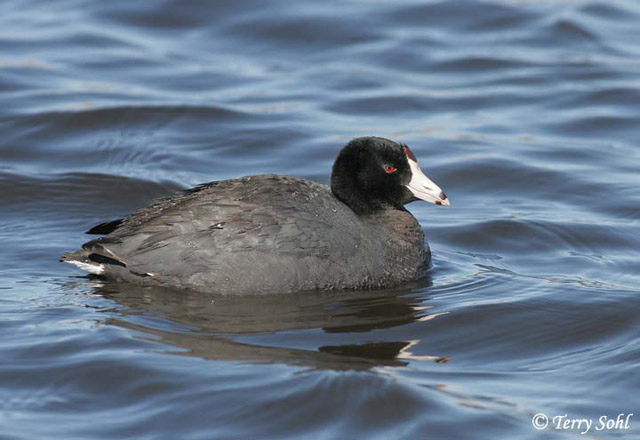 The American Coot is a very common summer resident, found in flocks on marshes and
sloughs throughout the state. A very adaptable bird, American Coots may
also be seen waddling awkwardly in fields and lawns adjacent to water
bodies. They are not graceful fliers either, requiring a long
"running" start to get airborne, pattering their feet on the surface of the
water.
The American Coot is a very common summer resident, found in flocks on marshes and
sloughs throughout the state. A very adaptable bird, American Coots may
also be seen waddling awkwardly in fields and lawns adjacent to water
bodies. They are not graceful fliers either, requiring a long
"running" start to get airborne, pattering their feet on the surface of the
water.
Habitat:
Marshes and sloughs, preferably those that also have adjacent open water. Also may feed on dry land.
Diet:
Omnivorous, eating aquatic plants, grasses, seeds, insects, earthworms, small fish, tadpoles, snails, eggs, and fruits and berries.
Behavior:
Feeds both in the water and on land. In the water, they may act like dabbling ducks, upending in shallow water, or may dive underwater. They will also readily forage on land near water bodies.
Nesting:
May through July. The nest of an American Coot is a floating nest of wetland vegetation such as bulrushes and cattails. The female lays between 4 and 11 eggs, and both parents help to incubate them. When the eggs hatch, the young leave the nest within hours, following the parents who feed them. The young fledge after about 7 weeks.
Song:
American Coots have a variety of vocalizations, including various grunts and croaks and a whiny kee-cue, kee-cue.
- Click here to hear the kee-cue calls of an American Coot1
- Click here to hear a squawking call of an American Coot (often something similar is heard when they feel threatened and move away)2
- Click here to hear a croacking call of an American Coot3
Interactive eBird Map:
Click to access an interactive eBird map of American Coot sightings
Migration:
Summers throughout much of North America. Northern populations migrate south in the winter (including those in South Dakota). However, they do often tend to stay late into the fall, and arrive relatively early in the spring.
Similar Species:
American Coots can be differentiate from the waterfowl and other birds they tend to hang around due to their unique structure, and basic black plumage with unique light bill. However, they could potentially be confused with the following species:
- Common Gallinule - Common Gallinule are primarily found east of South Dakota, although they are found in the far eastern part of the state on occasion. The white "shield" on the forehead of an American Coot is replaced by a red one on the Common Gallinule. They also have brown tones on their back that are lacking from Common Coot, and white patches on their sides.
- Purple Gallinule - Purple Gallinule are typically not found in South Dakota, as their normal range is far to the southeast. Where the two species cross paths, Purple Gallinule can be differentiated from American Coots by their dark purplish body and dark greenish back, with a red and yellow bill and bluish forehead shield.
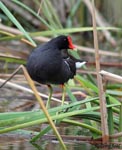 |
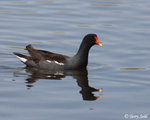 |
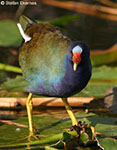 |
| Common Gallinule | Common Gallinule | Purple Gallinule |
Conservation Status:
American Coot populations have declined throughout much of their former range due to habitat loss, and that loss is evidently still continuing, as systematic surveys in recent decades continue to show modest declines. However, they are still common to abundant where habitat is available. The IUCN lists the American Coot as a species of "Least Concern".
Further Information:
Photo Information:
May 27th, 2007 - Atkin's Slough in Lincoln County, South Dakota - Terry Sohl
Additional Photos:
Click on the image chips or text links below for additional, higher-resolution American Coot photos.
Audio File Credits:
- 1Sunny Tseng. Recorded in Burnaby Lake Regional Park in British Columbia on November 11th, 2019. Original recording and information available from xeno-canto.
- 2Paul Marvin. Recorded in Santa Ana National Wildlife Refuge in Texas on December 18th, 2017. Original recording and information available from xeno-canto.
- 3Paul Marvin. Recorded in Imperial County, California on January 30th, 2018. Original recording and information available from xeno-canto.
| Click on the map below for a higher-resolution view |
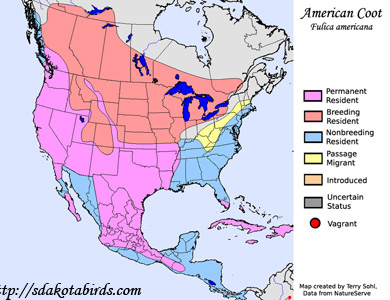 |
| South Dakota Status: Common summer resident throughout the state. Rare in winter. |
Click for a higher-resolution version of these photos
